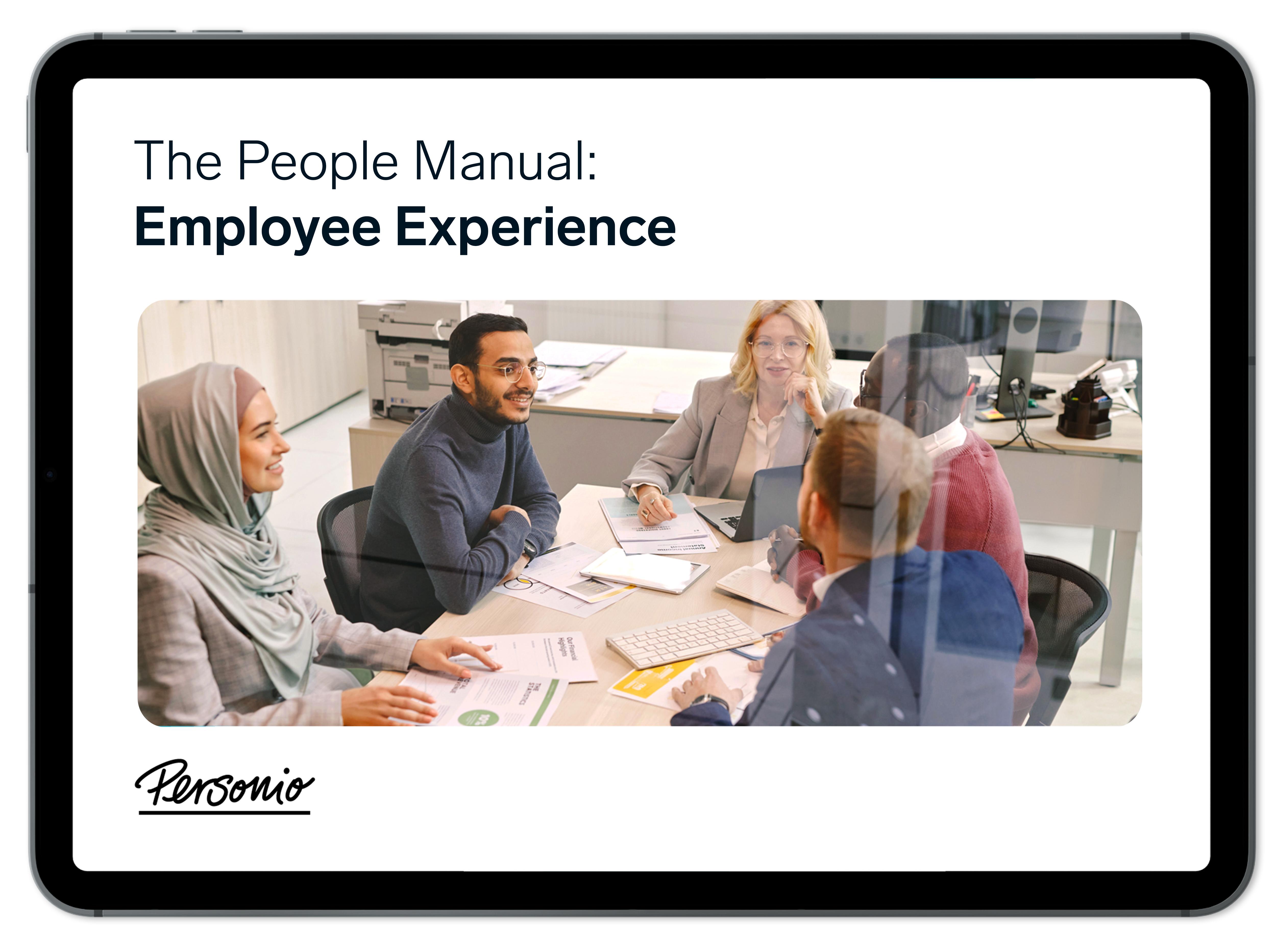Outcomes vs Outputs: The Difference Is in the Details

Managing a team's outcomes vs outputs is a balancing act. You have to be strategic with your "how"—AKA your outputs—while also keeping your sights set on your “why”—AKA your outcomes.
And while identifying business outcomes and designing the outputs to achieve them may seem like a task fit for leadership alone, HR plays a pivotal role in the process, too. Here’s how.
Ready to focus on every element of employee experience? Download our guide.What Are Outcomes And Outputs?
Outcomes and outputs are two different steps in the process of delivering a result. The output is the method, and the outcome is the result.
Let’s look at a simple, real-world example:
It’s Mother’s Day, so you go to your favourite local flower shop to pick up a bouquet. You deliver them to your mum, who’s impressed, appreciative, and in love with her new fresh centrepiece.
What was the output in this transaction, and what was the outcome? First, the output was the florist arranging the bouquet and selling it to you.
And while you might have assumed the flowers were the outcome, it was actually your mother’s experience; the joy, appreciation, and pride she felt.
It’s this—the outcome—that teams so often forget to focus on. Instead, they’re more focused on the outputs, which can do more harm than good.
Outcomes Vs Outputs: What’s The Difference?
Let’s dig a bit deeper into how outcomes vs outputs differ in the workplace.
In a business, your outputs allow you to reach your outcomes. Output examples include products, services, programs, profits, projects, milestones, initiatives, and more. In terms of measurability, it’s fairly simple: The output is either delivered/completed, or it’s not.
Outcomes are the impact made by those products, services etc., and should be valuable experiences for the end-user. They’re measurable and prove that your outputs are working as intended.
Let’s look at an example:
Say your product-based business wants to increase customer loyalty. So, your team was tasked with creating a customer-facing app that allows users to load money onto their account, pre-order their purchases, and earn rewards they can redeem for free or discounted items.
In this case, the app you create is your output.
Your outcomes wouldn’t be the number of customers who downloaded the app, but how long they successfully used and engaged with it (therefore remaining loyal to your company) and the positive experiences they took away from it.
You could then measure customer loyalty and retention driven by the app, proving that your output helped you achieve your business outcome.
A similar school of thought is used in sales and marketing, where you shouldn’t focus on the features of a product or service you’re trying to sell. You should focus on the benefits it brings to the end-user.
In both instances, you’re putting your client or customers’ needs and desires first.
Half a decade of insights on employee experience

Our "People Manual" covers all things related to employee experience and developing initiatives that result in more engaged employees. Grab your free copy right now.
Download It TodayThe Business Benefits Of Identifying Outcomes Vs Outputs
By defining your outputs and outcomes, your team can design an effective path to achieving your ideal results.
You’ll want to work backwards:
Identify your goal.
Define your outcomes (the results you hope to achieve).
Choose your output (the method you’ll use to achieve your results).
To identify the outputs and outcomes that will most effectively help your team reach their ideal results, you have to understand your end-user:
What do they want or need from your business?
What are their pain points?
How does your business/product solve them?
What benefits will they gain from working with your business?
How will it positively impact their life?
How will it make them feel?
Defining your outputs and outcomes not only allows you to better empathize and serve your customers but also leads to clearer processes, more engaged employees, and more opportunities for innovation for your team:
You’ll Never Lose Sight Of The Goal
When you know your outcomes, you can stay focused on what really matters. Your outcome should stay the same, but your output may change depending on your results and progress.
You’ll Avoid Confusion And Employee Disengagement
Say your organization’s leaders establish an outcome. Then, team members much farther down the corporate ladder are tasked with producing the output. This, of course, is fine—but only if the team members involved are clear on why they’re producing the output.
Employees Won’t Waste Time And Energy
Confusion can also cost you time and money. When employees aren’t confident in the purpose behind their work, they might put too much time and energy into an aspect of the project that’s not as important because they don’t know the real focus of it.
You’ll Stay Off The Hamster Wheel
When leaders focus too much on the outputs and not enough focus on the outcomes, they put their employees on a hamster wheel. The employees will keep working away on the output, but it never brings them any closer to their goal.
Understanding Business Outcomes
Business outcomes are specific, well-defined, and measurable results put forth to improve performance metrics.
To determine business outcomes, leaders need to define a measurable goal, determine the time frame in which they need to achieve their goal, and consider how it impacts both their team and their clients or customers.
Some examples of common business outcomes include:
Outcome | Explained |
|---|---|
Adaptability | To keep up with shifting markets and trends, your company may want to digitize your processes, integrate apps into your team and client communications, or expand your services and products with more modern solutions. |
Customer Relationships | This could include improving customer service, reviews, the overall customer experience, or long-term customer engagement and retention. |
Profitability | Whether you want to implement a strategy to scale your business or need to identify cost-saving opportunities, once you’ve determined your financial business outcome, you can set the output to get you on track to achieving it. |
Performance | Performance-related business outcomes can include hitting sales goals, increasing your market reach, or improving your industry reputation. |
What Are HR Outcomes?
HR outcomes are achieved through day-to-day activities, programs, and initiatives that aim to improve the employee experience.
HR outcomes also impact business outcomes. The more supported the employees are by the HR team, the higher quality of work they’ll produce, and the better their performance, which means higher profit and ROI for the organization.
These goals typically fall into one of the four following categories:
HR Outcome | Explained |
|---|---|
Employee Satisfaction | These goals help employees improve their overall happiness regarding their role, benefits, wages, work-life balance, opportunities for career advancement, and environment. |
Employee Motivation | How can you ensure employees are engaged in their work, motivated to do their best, and working towards achievable goals? In this case, your output could include creating recognition and rewards programs, referral programs, or learning and development courses. |
Employee Retention | In this case, HR is looking for more employee commitment and less turnover, which leads to a better business reputation, a more stable workplace environment, and higher quality of work from knowledgeable long-term employees. |
Employee Presence | If your data shows an uptick in absenteeism, late arrivals, or early departures, your output should include strategies to address the issue, such as disciplinary processes, reshaping PTO and holiday programs, or creating incentives for positive attendance records. |
How Can HR Support Business Outcomes?
One of the best ways HR can support a company’s business outcomes is with the help of an HR Business Partner (HRBP).
This role is specifically designed to help leaders design and execute an HR strategy that supports the companies’ growth, performance, and goals.
When the HRBP knows what their organization’s business outcomes are, they use their knowledge of the company and its people to give valuable input, optimize processes, and create outcome-driven solutions from within.
Can HR Software Help Your Team Manage Outcomes And Outputs?
With Personio, yes! You can use our HR software to streamline one of the first steps to managing outcomes and outputs: identifying your goals through data and information analysis.
You can access data and create reports, as well as manage other documentation around recruitment, pay, and employee development.
You can also keep your team on track to achieving your outcomes by monitoring their outputs and progress through approval processes, setting tasks and reminders, providing feedback, and more.

